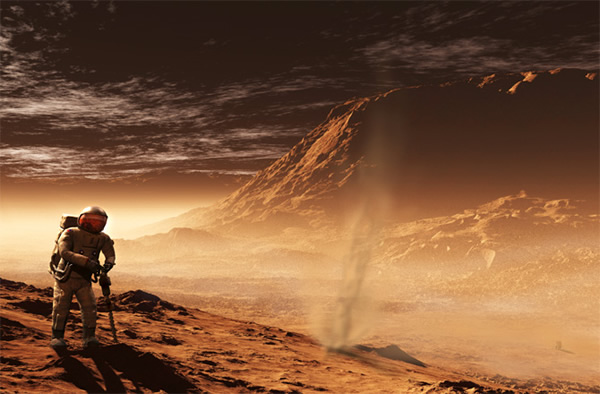Drug to Reduce Risk of Space Radiation Cancers?
A Mars astronaut works in the high radiation environment of the Martian surface -- can drugs be used to mitigate the worst health effects?
Mice fed an experimental anti-inflammatory drug three days before exposure to space-like radiation developed half as many carcinomas as mice that did not get the compound, a finding that has implications for astronauts on long-duration missions, as well as people on Earth receiving radiation treatments for therapeutic reasons, new research shows.
The compound, which is derived from plant moss, belongs to a family of drugs called synthetic triterpenoids, which in addition to easing inflammation appear have powerful antioxidant properties.
Synthetic triterpenoids already are in clinical trials and appear to be useful in treating kidney disease, diabetes, age-related macular degeneration, pulmonary diseases, Alzheimer’s, Parkinson’s and various cancers.
The idea to give irradiated mice food laced with a dose of the synthetic triterpenoid CDDO-Me stemmed from a previous series of experiments.
Researchers discovered that mice irradiated over several days developed more cancerous tumors than mice receiving a single hit of radiation, even though the total dosages were identical, Jerry Shaw, with the University of Texas Southwestern Medical Center in Dallas said at the American Society for Gravitational and Space Research conference in Orlando last week.
That got them wondering why.
The mice had been genetically modified to be susceptible to either lung cancer or colon cancer -- the first and second leading causes of cancer deaths in the United States.
Cells in the lungs tend to be replaced only when damaged, while colon cells turn over about every seven days, giving researchers two different processes to study.
Splitting up the radiation dose had similar effects on both groups. So did varying the type of radiation.
“This suggested that there was something about the fractioned dose of radiation that was leading to more invasive cancers,” Shaw said.
Scientists followed up with genetic studies and found a group of genes associated with inflammatory responses, a finding that led to comparative studies of human lung cancer patients and treatment outcomes.
At that point, Shaw and colleagues turned to CDDO-Me to see what impact the drug might have on irradiated mice. They found that about mice fed food laced with CDDO-Me three days before being irradiated developed fewer tumors than those that did not receive the compound.
For the lung cancer mice, the rate fell from 35 percent to 17 percent with the drug. Another group of lung cancer-prone mice exposed to radiation similar to what is produced during a solar storm cut its tumor rate from 30 percent to 19 percent with the drug, Shaw said.
“This certainly doesn’t cure the progression to invasive cancers, but it certainly does reduce the number significantly,” Shaw said.
Among the mice susceptible to colon cancer, 9 percent developed cancerous tumors after ingesting CDDO-Me, compared to 26 percent that developed cancerous tumors without the drug.
Cell cultures suggest the drug also is effective if taken within an hour after radiation exposure, Shaw added.
“We think there is going to be a good rationale for moving forward with developing biological mitigators and biological countermeasures that reduce localized inflammatory responses,” he said.
The research also raises the prospect that some astronauts may be more genetically more resistant to developing cancers than others.
“The future is looking at individual sensitivity, but we can’t do it today,” said radiation scientist Francis Cucinotta, with the University of Nevada Las Vegas.(Nov 13, 2013 06:23 PM ET // by Irene Klotz)












